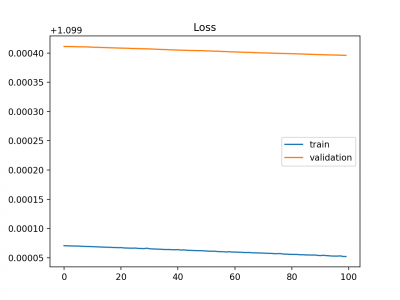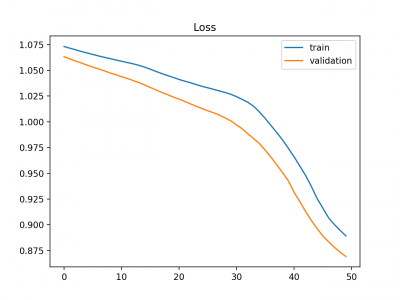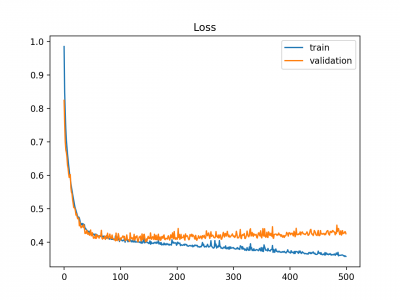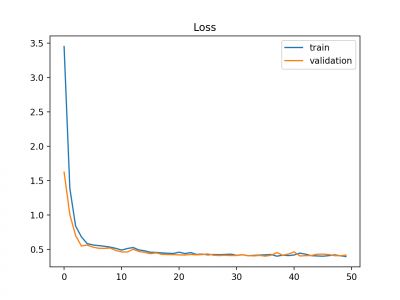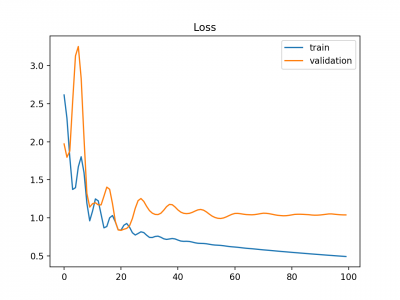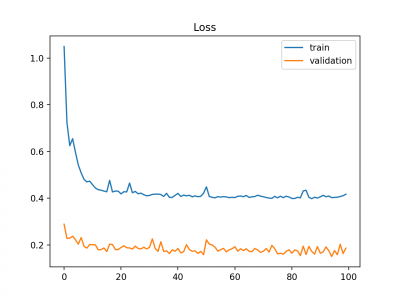Keras: Introduction to Learning Curves for Diagnosing Model Performance
Learning Curve (Kurva Pembelajaran) adalah plot model kinerja belajar terhadap experience atau waktu.
Kurva pembelajaran adalah alat diagnostik yang banyak digunakan dalam machine learning untuk algoritma yang belajar dari set data training secara bertahap. Model dapat dievaluasi pada dataset training dan pada dataset validasi setelah setiap update selama training dan plot kinerja yang diukur dapat dibuat untuk menunjukkan kurva pembelajaran.Reviewing learning curves of models during training can be used to diagnose problems with learning, such as an underfit or overfit model, as well as whether the training and validation datasets are suitably representative.
Dalam tulisan ini, anda akan menemukan kurva pembelajaran dan bagaimana kurva tersebut dapat digunakan untuk mendiagnosis perilaku pembelajaran dan generalisasi model machine learning, dengan contoh plot yang menunjukkan masalah pembelajaran umum.
Sesudah membaca tulisan ini, anda akan mengetahui tentang:
- Kurva pembelajaran adalah plot yang menunjukkan perubahan dalam kinerja pembelajaran dari waktu ke waktu dalam hal experience.
- Kurva pembelajaran kinerja model pada dataset train dan dataset validasi dapat digunakan untuk mendiagnosis model apakah underfit, overfit, atau well-fit (cocok)..
- Kurva pembelajaran kinerja model dapat digunakan untuk mendiagnosis apakah set data train atau validasi relatif tidak mewakili domain masalah.
Overview
Tutorial ini di bagi menjadi tiga (3) bagian, yaitu:
- Kurva Pembelajaran (Learning Curve)
- Mendiagnosa Perilaku Model (Diagnosing Model Behavior)
- Mendiagnosa Dataset yang tidak representatif.
Kurva Pembejaran (Learning Curve) di Machine Learning
Umumnya, kurva belajar adalah plot yang menunjukkan waktu atau pengalaman (experience) pada sumbu x dan pembelajaran atau peningkatan pada sumbu y.
Learning curves (LCs) are deemed effective tools for monitoring the performance of workers exposed to a new task. LCs provide a mathematical representation of the learning process that takes place as task repetition occurs. — Learning curve models and applications: Literature review and research directions, 2011.
Misalnya, jika anda mempelajari alat musik, kemahiran anda pada instrumen tersebut dapat dievaluasi dan diberi skor numerik setiap minggu selama satu tahun. Plot skor selama 52 minggu adalah kurva belajar dan akan menunjukkan bagaimana pembelajaran Anda terhadap instrumen telah berubah seiring waktu.
- Learning Curve: Line plot dari learning (y-axis) terhadap experience (x-axis).
Kurva pembelajaran banyak digunakan dalam machine learning untuk algoritma yang belajar (mengoptimalkan parameter internal mereka) secara bertahap, seperti deep learning neural network.
Metrik yang digunakan untuk mengevaluasi pembelajaran dapat dimaksimalkan, artinya skor yang lebih baik (angka yang lebih besar) menunjukkan lebih banyak pembelajaran. Contohnya adalah akurasi klasifikasi.
Lebih umum menggunakan skor yang diminimalkan, seperti loss atau error di mana skor yang lebih baik (angka lebih kecil) menunjukkan lebih banyak pembelajaran dan nilai 0,0 menunjukkan bahwa dataset training dipelajari dengan sempurna dan tidak ada error yang dibuat.
Selama training model machine learning, kondisi model saat ini pada setiap langkah algoritma training dapat dievaluasi. Hal ini dapat dievaluasi pada set data training untuk memberikan gambaran seberapa baik model tersebut “belajar.” Model ini juga dapat dievaluasi pada set data validasi yang bukan bagian dari set data training. Evaluasi pada dataset validasi memberikan gambaran tentang seberapa baik model tersebut untuk bisa “digeneralisasi.”
- Train Learning Curve: Learning curve calculated from the training dataset that gives an idea of how well the model is learning.
- Validation Learning Curve: Learning curve calculated from a hold-out validation dataset that gives an idea of how well the model is generalizing.
It is common to create dual learning curves for a machine learning model during training on both the training and validation datasets.
In some cases, it is also common to create learning curves for multiple metrics, such as in the case of classification predictive modeling problems, where the model may be optimized according to cross-entropy loss and model performance is evaluated using classification accuracy. In this case, two plots are created, one for the learning curves of each metric, and each plot can show two learning curves, one for each of the train and validation datasets.
- Optimization Learning Curves: Learning curves calculated on the metric by which the parameters of the model are being optimized, e.g. loss.
- Performance Learning Curves: Learning curves calculated on the metric by which the model will be evaluated and selected, e.g. accuracy.
Now that we are familiar with the use of learning curves in machine learning, let’s look at some common shapes observed in learning curve plots.
Diagnosing Model Behavior
The shape and dynamics of a learning curve can be used to diagnose the behavior of a machine learning model and in turn perhaps suggest at the type of configuration changes that may be made to improve learning and/or performance.
There are three common dynamics that you are likely to observe in learning curves; they are:
- Underfit.
- Overfit.
- Good Fit.
We will take a closer look at each with examples. The examples will assume that we are looking at a minimizing metric, meaning that smaller relative scores on the y-axis indicate more or better learning.
Underfit Learning Curves
Underfitting refers to a model that cannot learn the training dataset.
Underfitting occurs when the model is not able to obtain a sufficiently low error value on the training set. — Page 111, Deep Learning, 2016.
An underfit model can be identified from the learning curve of the training loss only.
It may show a flat line or noisy values of relatively high loss, indicating that the model was unable to learn the training dataset at all.
An example of this is provided below and is common when the model does not have a suitable capacity for the complexity of the dataset.
An underfit model may also be identified by a training loss that is decreasing and continues to decrease at the end of the plot.
This indicates that the model is capable of further learning and possible further improvements and that the training process was halted prematurely.
A plot of learning curves shows underfitting if:
- The training loss remains flat regardless of training.
- The training loss continues to decrease until the end of training.
Overfit Learning Curves
Overfitting refers to a model that has learned the training dataset too well, including the statistical noise or random fluctuations in the training dataset.
… fitting a more flexible model requires estimating a greater number of parameters. These more complex models can lead to a phenomenon known as overfitting the data, which essentially means they follow the errors, or noise, too closely. — Page 22, An Introduction to Statistical Learning: with Applications in R, 2013.
The problem with overfitting, is that the more specialized the model becomes to training data, the less well it is able to generalize to new data, resulting in an increase in generalization error. This increase in generalization error can be measured by the performance of the model on the validation dataset.
This is an example of overfitting the data, […]. It is an undesirable situation because the fit obtained will not yield accurate estimates of the response on new observations that were not part of the original training data set. — Page 24, An Introduction to Statistical Learning: with Applications in R, 2013.
This often occurs if the model has more capacity than is required for the problem, and, in turn, too much flexibility. It can also occur if the model is trained for too long.
A plot of learning curves shows overfitting if:
- The plot of training loss continues to decrease with experience.
- The plot of validation loss decreases to a point and begins increasing again.
The inflection point in validation loss may be the point at which training could be halted as experience after that point shows the dynamics of overfitting.
The example plot below demonstrates a case of overfitting.
Good Fit Learning Curves
A good fit is the goal of the learning algorithm and exists between an overfit and underfit model.
A good fit is identified by a training and validation loss that decreases to a point of stability with a minimal gap between the two final loss values.
The loss of the model will almost always be lower on the training dataset than the validation dataset. This means that we should expect some gap between the train and validation loss learning curves. This gap is referred to as the “generalization gap.”
A plot of learning curves shows a good fit if:
- The plot of training loss decreases to a point of stability.
- The plot of validation loss decreases to a point of stability and has a small gap with the training loss.
Continued training of a good fit will likely lead to an overfit.
The example plot below demonstrates a case of a good fit.
Diagnosing Unrepresentative Datasets
Learning curves can also be used to diagnose properties of a dataset and whether it is relatively representative.
An unrepresentative dataset means a dataset that may not capture the statistical characteristics relative to another dataset drawn from the same domain, such as between a train and a validation dataset. This can commonly occur if the number of samples in a dataset is too small, relative to another dataset.
There are two common cases that could be observed; they are:
- Training dataset is relatively unrepresentative.
- Validation dataset is relatively unrepresentative.
Unrepresentative Train Dataset
An unrepresentative training dataset means that the training dataset does not provide sufficient information to learn the problem, relative to the validation dataset used to evaluate it.
This may occur if the training dataset has too few examples as compared to the validation dataset.
This situation can be identified by a learning curve for training loss that shows improvement and similarly a learning curve for validation loss that shows improvement, but a large gap remains between both curves.
Unrepresentative Validation Dataset
An unrepresentative validation dataset means that the validation dataset does not provide sufficient information to evaluate the ability of the model to generalize.
This may occur if the validation dataset has too few examples as compared to the training dataset.
This case can be identified by a learning curve for training loss that looks like a good fit (or other fits) and a learning curve for validation loss that shows noisy movements around the training loss.
It may also be identified by a validation loss that is lower than the training loss. In this case, it indicates that the validation dataset may be easier for the model to predict than the training dataset.
Further Reading
This section provides more resources on the topic if you are looking to go deeper. Books
Deep Learning, 2016. An Introduction to Statistical Learning: with Applications in R, 2013.
Papers
Learning curve models and applications: Literature review and research directions, 2011.
Posts
How to Diagnose Overfitting and Underfitting of LSTM Models Overfitting and Underfitting With Machine Learning Algorithms
Articles
Learning curve, Wikipedia. Overfitting, Wikipedia.
Summary
In this post, you discovered learning curves and how they can be used to diagnose the learning and generalization behavior of machine learning models.
Specifically, you learned:
- Learning curves are plots that show changes in learning performance over time in terms of experience.
- Learning curves of model performance on the train and validation datasets can be used to diagnose an underfit, overfit, or well-fit model.
- Learning curves of model performance can be used to diagnose whether the train or validation datasets are not relatively representative of the problem domain.
Referensi
